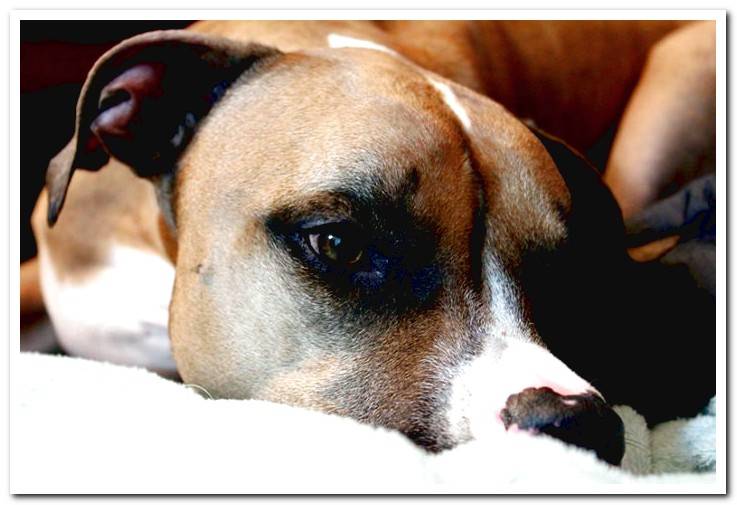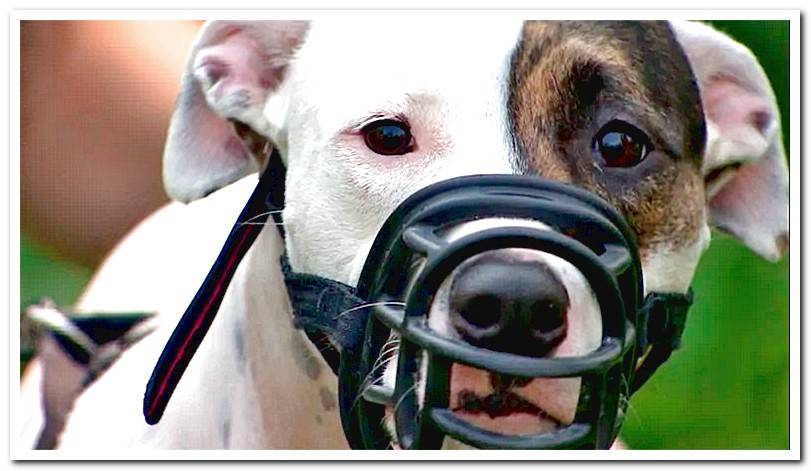
Just as there are dog breeds with a friendlier character, there are others that – if not properly socialized – can cause problems both in the domestic sphere and in public spaces. Currently there are eight varieties considered as potentially dangerous dogs in Spain.
Of course, not all specimens within this risk group are aggressive. It’s just that, due to characteristics like their physical power, their strong bite or their particular temperament, they could cause serious injuries if they were to attack. Let’s take a closer look at everything you need to know if you are considering adopting one of these breeds.
Index of contents
- 1 What are the potentially dangerous dog breeds in Spain?
- 1.1 Pitbull Terrier
- 1.2 Staffordshire Bull Terrier
- 1.3 American Staffordshire Terrier
- 1.4 Rottweiler
- 1.5 Argentine Dogo
- 1.6 Brazilian Row
- 1.7 Akita Inu
- 1.8 Tosa Inu
- 2 What characteristics do potentially dangerous dogs have in Spain?
- 3 How can I adopt a PPP dog in Spain?
- 4 Safety measures for a potentially dangerous dog
What are the potentially dangerous dog breeds in Spain?
PPP breeds have in common their great build and strong dominance instincts. In addition, many were originally developed for functions such as big game or dogfighting, so his inheritance of aggressiveness can remain latent in the instincts of a horse. These races are the following:
Pitbull Terrier
These dogs have a dominant character, to which is added their exuberant physical power. Also, their fighting dog heritage makes them naturally aggressive if they don’t socialize well and are firmly taught from an early age.
Staffordshire Bull Terrier
Originally from Great Britain, these dogs were bred to control cattle three to four times larger than themselves. thanks to its powerful bite. In the Middle Ages they were used in fighting against bulls and bears. This fighting instinct could become a threat to humans.
American Staffordshire Terrier
The American variety of the Staffordshire Terrier shares its genetic aggressiveness. Its muscular chest and ingrained territorial instincts make it a complex strain to instruct, unsuitable for novices.
Rottweiler
Many are surprised to find these dogs on the list, but it is due to their powerful bite, their great weight and their extraordinary physical power, which makes them difficult to control. These dogs must be firmly educated since childhood to eradicate their dominant temperament, because when they get out of control they can be very aggressive.
Argentine Dogo
Their size and strong pincer bite make them part of this group, although it is very unusual for them to attack humans. If they are well socialized since childhood they are great companions for all family members, including children.
Brazilian Row
Very self-confident and extremely faithful to their family, these dogs are naturally suspicious of people or dogs they don’t know. They are territorial and dominant, which makes them good guardians but a little unstable in the presence of the public.
Akita Inu
These large dogs are of Japanese origin. Its first function was to protect the great feudal residences. They are naturally suspicious of unknown people and dogs, although at home they tend to be very attached to their own. However, it is not recommended to leave them alone with young children.
Tosa Inu
They also come from Japan. His stubborn personality and dominant temperament can be difficult to control. They usually take up to four years to reach adulthood, which makes them not fully aware of the damage they can cause due to their robust anatomy.
What characteristics do potentially dangerous dogs have in Spain?
The current legislation establishes what conditions must be met for a breed to register as dangerous in Spain. These are:
- Strong, dominant and territorial personality.
- Well marked value
- Well-developed muscles, powerful looks, and robust anatomy
- Short hair
- Wide and short neck
- A deep chest, with an arched chest, a short and very strong back.
- Cube-shaped head and wide skull.
- Strong, oversized jaw with a deep, scissor-bitten mouth.
- Straight and robust front legs, as well as well-muscled, long and angled rear ones.
- The perimeter of the thorax must be between 60 and 80 cm; the height at the withers is between 50 and 70 cm, while the weight has to be over 20 kilos.
In addition to these considerations, it is necessary to know that a specimen that arises from the crossing of these breeds will also be added to the list. But this is not all: any dog that behaves aggressively can be declared dangerous if the request is endorsed by a registered veterinaryn.
Likewise, there are discrepancies between the different Spanish autonomous communities about which breeds are considered dangerous. Therefore, it is always a good idea to find out about this issue at your Town Hall.
How can I adopt a PPP dog in Spain?
As a first step, those who wish to be cared for by a potentially dangerous dog in Spain must obtain a license establishing that they meet the following requirements:
- Be over 18 years old.
- Not have convictions of homicide, injuries, torture, or have been convicted of crimes against liberty or against moral integrity, sexual liberty and public health, association with an armed or drug gang.
- Neither can access these dogs who are prohibited by law from owning dangerous animals. Similarly, people sanctioned for serious or very serious infractions against section 3 of article 13 of Law 50/1999, of December 23, on the legal regime of potentially dangerous animals are not accepted.
- Be in physical and mental condition suitable for the possession of one of these dogs. For this, a physical and psychological examination must be passed in which your auditory, visual, neurological and locomotor system abilities are evaluated.
- Accredit the payment of liability insurance for damages to third parties with a coverage of at least 120,000 euros.
- The license expires after five years. To renew it, the adoption holder must continue to comply with the previously explained physical and legal conditions.
In addition to these administrative requirements, if you want to adopt a potentially dangerous dog in Spain, you have a series of obligations that you must know.

Safety measures for a potentially dangerous dog
The risk of having a dog with these characteristics increases in public spaces. For this reason, the most important measures you should take are aimed at prevention during walks:
- Whenever you walk your dog, you must carry a license and a receipt for its registration in the municipal registry.
- It is absolutely essential that they go outside with a muzzle.
- Extensible belts or those of more than 2 m in length are not allowed.
- A person can only walk a dog of these characteristics at the same time, never two or more.
- Such a dog can never be walked by a minor.
- These dogs are not allowed to be untied or outside of properly delimited and closed areas, even if they are private property.
- In the event of the loss of the animal or the suspicion that it has been stolen, you must notify the authorities within the first 48 hours of its disappearance.
Failure to comply with these rules entails fines of up to 15,000 euros. And, in case they caused harm to someone, it is the person who has adopted the dog who is considered responsible.
Beyond these regulations, the key to achieving a balanced and peaceful example – whatever breed it may be – is proper socialization as a puppy and an education that prioritizes respect, firmness and affection.
